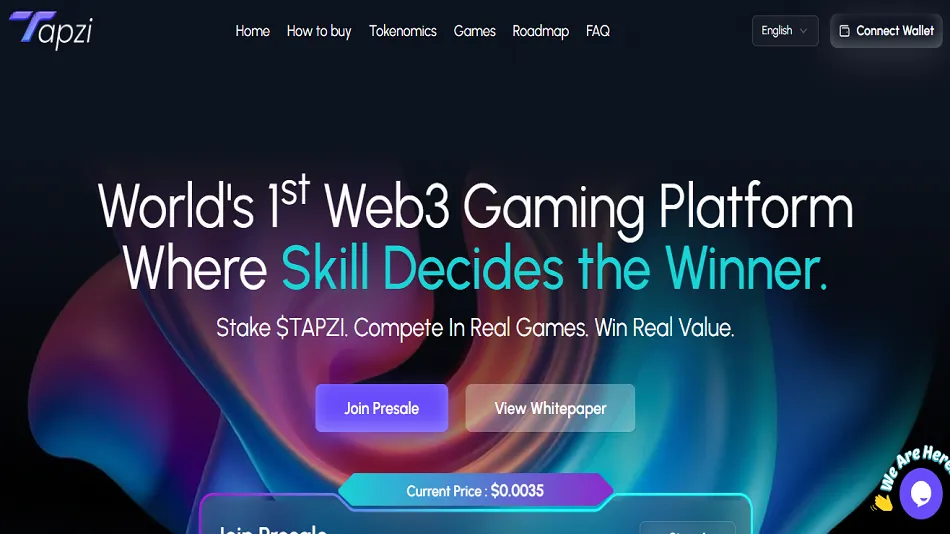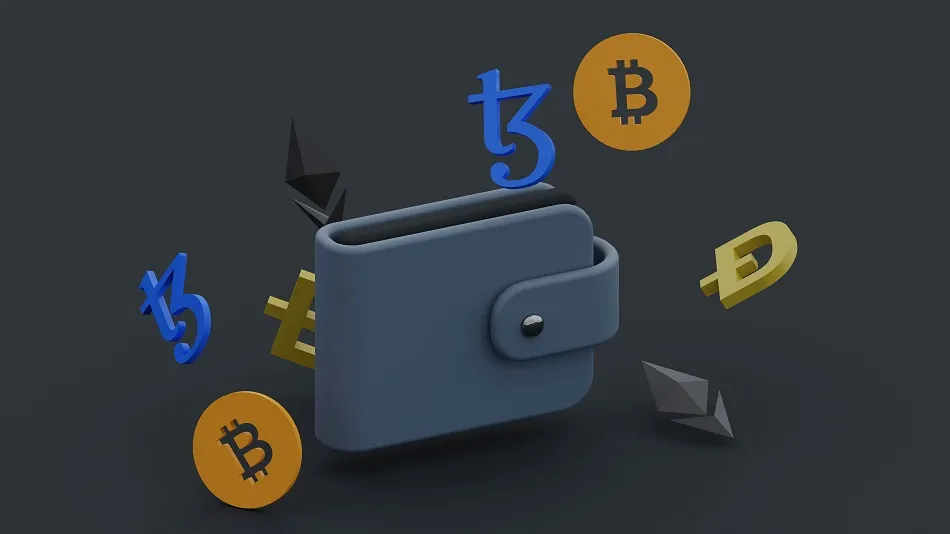10 Best Web3 Coins 2025 – List
Here’s a quick overview of the best Web3 cryptocurrencies to invest in today:
- TAPZI ($TAPZI): A Web3 project focused on digital asset innovation and blockchain utility.
- Chainlink ($LINK): A decentralized oracle network connecting smart contracts with real-world data.
- Sandbox ($SAND): A virtual world where users can create, own, and monetize gaming experiences.
- Arbitrum ($ARB): A Layer-2 scaling solution that makes Ethereum transactions faster and cheaper.
- Filecoin ($FIL): A decentralized storage network that allows users to buy and sell unused data space.
- Internet Computer ($ICP): A blockchain platform designed to run smart contracts and dApps at web speed.
- Ethereum ($ETH): A decentralized blockchain powering smart contracts and decentralized applications.
- The Graph ($GRT): A protocol for indexing and querying blockchain data for decentralized applications.
- Decentraland ($MANA): A 3D virtual world where users can buy land, build, and interact through NFTs.
- Polygon ($MATIC): A Layer-2 scaling solution that improves Ethereum’s speed and reduces transaction costs.
Best Web3 Coins to Watch in August 2025
With over 20,000 cryptocurrencies in existence, identifying genuine gems is crucial. Most lack utility, but the Web3 coins token offer transformative technology and strong tokenomics.
We have reviewed the Web3 crypto coins list to buy to streamline your research and help you make an informed decision for 2025.
1. Tapzi ($TAPZI) – The World’s First Skill-Based, Decentralized Web3 Gaming Platform
Tapzi is a skill-based Web3 gaming platform where you play classic titles and win real value by outthinking opponents, not by rolling dice or chasing jackpots.
It focuses on fair head-to-head matches – Chess, Checkers, Tic-Tac-Toe, and Rock-Paper-Scissors—so outcomes come from strategy, timing, and clean execution. Before a match, both players stake $TAPZI; the winner receives the pooled tokens, creating direct, transparent rewards without treasury subsidies or artificial emissions.
This peer-to-peer structure feels sustainable because it aligns incentives: play better, earn more, and avoid the “inflate then crash” loop common in many GameFi models. Built on BNB Smart Chain, Tapzi keeps transactions quick and cheap, while instant web and mobile access removes the usual wallet friction that scares casual gamers.
Accessibility plus competitive integrity stand out: an ELO-style ranking aims for fair matchmaking, and the token’s fixed supply is 5,000,000,000 $TAPZI with team tokens locked 12 months then vesting 18 months.
Under the hood, $TAPZI uses a hybrid approach: games run off-chain for speed and settle on-chain with signed results, giving verifiable outcomes without lag. Anti-cheat layers – signed states, on-chain records, and replay audits—support trust, which is essential when every move may decide who takes the prize pool.
Utility is clear beyond matches: tournaments, loyalty staking access, and future cosmetic NFTs add reasons to hold and use $TAPZI without touching gameplay balance. The token distribution looks balanced across presale, liquidity, ecosystem development, marketing, team, treasury, airdrops, and user rewards, reducing concentration risk and supporting growth.
Still, success depends on smooth matchmaking at scale, strong bot resistance, and onboarding non-crypto players with simple flows that “just work” on phones and browsers. The roadmap highlights Q4 2025 PancakeSwap listing and a mainnet beta, while allocations include 20% presale, 20% liquidity, 15% treasury, and 10% each for team, marketing, and ecosystem.
| Token Symbol |
$TAPZI |
| Presale Supply |
1 billion |
| Network |
BNB Smart Chain |
| Payment Method |
ETH, USDT, USDC, POL, SOL, TRX, BNB, and a card |
2. Chainlink ($LINK): The Bridge for Real-World Data
Chainlink (LINK) is a decentralized oracle network providing smart contracts with reliable access to off-chain data, such as APIs, data feeds, and traditional payment systems. It acts as a bridge that enables blockchains to interact securely with external resources, supporting DeFi, insurance, gaming, and more.
From a tokenomics standpoint, LINK has a fixed total supply of 1,000,000,000 LINK, of which roughly 678.1 million are currently in circulation, representing about 68% of the maximum supply. This cap introduces scarcity, making LINK non-inflationary—an increase in demand likely correlates with price appreciation—as seen in its capped supply model
LINK is used in two primary ways: as payment to oracle node operators for data provision, formatting, and uptime guarantees, and as collateral (i.e., deposits) to keep operators honest.
This aligns economic incentives and ensures network trust. The token supports various networks beyond Ethereum (e.g., Polygon, BSC, Avalanche) and advanced features under the 2.0 protocol, including secure off-chain computation and hybrid smart contracts.
In summary, LINK’s 1 billion supply cap, substantial ~68% circulating rate, and dual role as both payment and stake make it a foundational token for reliable, decentralized oracle services.
| Token Symbol | LINK |
| Total Supply | 1,000,000,000 |
| Network | ERC-677 |
| Payment Method | ETH or USDT |
3. The Sandbox ($SAND): Create and Play in Your Own Metaverse
The Sandbox (SAND) is the native token of a blockchain-based virtual world and metaverse platform. Built primarily on Ethereum as an ERC-20 token, it powers creative interactions through NFTs, gaming, LAND ownership, and a play-to-earn economy.
SAND has a fixed total supply of 3,000,000,000 SAND, making it non-inflationary by design. Users need SAND to purchase land, customize avatars, trade digital assets, and participate in governance and staking within the ecosystem.
Token allocations include approximately 31% to founders and team (with vesting), and about 26% to company reserves and ecosystem development—underscoring long-term growth incentives.
SAND also serves as a governance token in the DAO model; holders can propose and vote on platform updates, and staking SAND allows users to earn rewards—such as a share of ecosystem transaction revenue.
In essence, SAND’s 3 billion fixed supply, broad utility spanning transactions, governance, and staking, and structured token allocation make it the economic backbone of The Sandbox metaverse.
| Token Symbol | SAND |
| Total Supply | 3,000,000,000 |
| Network | ERC-20 |
| Payment Method | SOL. ETH, USDT, or USDC |
What are Web3 Coins? The Foundation of a Decentralized Internet
Web3 coins, or tokens, are the digital assets that power the next evolution of the internet: a user-owned, decentralized web built primarily on blockchain technology.
Unlike Web 2.0, where tech giants control platforms and user data, Web3 aims to return ownership to users through protocols that enable peer-to-peer interactions.
These coins serve specific utilities within their ecosystems; they are not just currencies. For instance, they can be used to pay for transaction fees (gas), access services, govern protocol changes, or represent ownership of digital or physical assets.
The total market capitalization of Web3 crypto has consistently exceeded $25 billion, highlighting its significant economic footprint. Essentially, by holding and using these tokens, you are not just investing but actively participating in and governing the decentralized networks that could form the backbone of our future digital lives, from finance to social media.
5 Compelling Reasons to Invest in Web3 Coins in 2025
Reason 1: Web3 is the Next Evolutionary Phase of the Internet
Which Web3 Coins are Leading the Market in 2025?
Reason 2: Massive Venture Capital is Flowing into the Web3 Ecosystem
Institutional interest brings more than cash; it delivers professional governance, product rigor, and the partnerships early networks need to scale. Venture funds are backing full stacks—from base layers and rollups to data availability, wallets, oracles, and vertical apps—creating a pipeline where successful infrastructure can funnel users into consumer dApps.
This capital also subsidizes developer tooling, audits, and onboarding UX, compressing the time from prototype to mainstream product. While VC attention can be cyclical, it often seeds durable platforms that outlast market swings, as we saw with cloud and AI.
For investors, following smart money into key primitives (storage, identity, interoperability) can identify resilient projects. The presence of long-horizon backers also increases the odds of responsible treasury management, clearer milestones, and timely disclosures that reduce information asymmetry.
Reason 3: Real-World Utility and Decentralized Applications (dApps) are Booming
Web3 is moving beyond speculation into payments, gaming assets, identity, decentralized data, and tokenized real-world assets that settle on-chain. Consumer-friendly wallets, account abstraction, and fiat onramps are shrinking the gap between Web2 convenience and Web3 ownership, bringing everyday use cases into reach.
Interoperability standards and modular blockchains let teams ship faster and cheaper, while oracle networks connect contracts to real-world events. This breadth of utility means token demand can be tied to actual usage—gas, staking, or access—rather than pure narrative.
Payments settle globally in minutes with programmable rules.
Gaming items become tradable assets users can actually own.
Decentralized identity reduces repeated KYC and password sprawl.
Data and storage protocols reward contributors, not platforms.
Tokenized assets bring 24/7 markets to traditionally illiquid domains.
Oracles and automation enable trust-minimized business workflows.
How do Web3 Projects Typically Distribute Tokens at Launch?
When a Web3 project launches a token it’s not just about “mint and sell”—token distribution (tokenomics) is a strategic plan that balances funding, incentives and decentralization.
Common channels include private/seed sales (early backers and VCs), public sales (ICOs / IEOs / IDOs), airdrops to attract users, liquidity mining / staking rewards to bootstrap on-chain activity, and allocations for team, advisors and a project treasury.
Projects almost always use vesting schedules so team and investor tokens unlock over months or years to avoid immediate sell pressure; typical vesting windows for teams are often 2–4 years.
Allocation mixes vary wildly by project (some reserve 10–25% for team, 20–40% for treasury/eco, single-digit % for public sale), and modern launches increasingly emphasize community and reward pools over large public sale allocations. For practical reading on industry allocation patterns and vesting best practices see tokenomics guides and allocation benchmarks.
Reason 4: Early-Stage Web3 Projects Offer Ground-Floor Opportunities
Because networks launch openly, retail can access early projects alongside institutions, often through public sales, staking, testnets, and ecosystem grants. Token incentives reward users for providing liquidity, security, or content, letting communities co-own growth rather than renting access from centralized platforms.
Early positioning carries higher risk, but it also captures network effects as liquidity, developers, and integrations compound. Disciplined research—whitepapers, audits, governance forums, and tokenomics—can separate experiments from durable protocols.
Diversifying across infra, middleware, and apps helps balance upside with survivorship risk.
Look for credible teams, shipped code, and transparent roadmaps.
Favor fair or progressive token distributions over heavy insider allocations.
Track developer activity, partner integrations, and mainnet usage.
Assess runway and treasury strategy to weather downcycles.
Evaluate utility: staking, fees, access rights, or burn mechanisms.
Use position sizing and vesting awareness to manage volatility.
Reason 5: Investing in Web3 is a Bet on the Future of Digital Ownership
Web3 enables provable ownership of money, media, identities, and credentials that persist across applications, devices, and borders. Instead of renting access from platforms, users hold assets in wallets they control, with cryptography replacing corporate permission as the source of truth.
This shift realigns value: creators receive automated royalties, communities govern shared treasuries, and users can move their data and assets without losing history. For investors, ownership rails translate into defensible demand for tokens that secure networks, pay for computation, or grant participation rights.
As more of the economy becomes natively digital—from memberships to real estate titles—on-chain registries and settlement layers can underwrite that activity. A portfolio slice in Web3 therefore expresses a long-term conviction: that the internet’s future belongs to users who own what they create, earn, and build.
How Many Web3 Coins and Tokens Exist?
There’s no single “correct” number because different trackers use different inclusion rules (active vs. created vs. delisted), but the answer is: lots—tens of thousands of distinct tokens are tracked by major aggregators, and the count keeps changing every day.
For example, CoinGecko and CoinMarketCap list on the order of tens of thousands of crypto assets (CoinGecko often shows ~16–17k, while CoinMarketCap’s various counts can be much larger depending on what they include). Many assets are low-activity, experimental or short-lived; only a fraction have meaningful liquidity or user activity.
Because new tokens (and wrapped/bridge copies) appear constantly, always check a price tracker like CoinGecko or CoinMarketCap for the current tally if you need an exact number.
How to Discover the Best Web3 Coins to Invest in 2025
The Web3 coin market, valued in the tens of billions, is expanding rapidly. While platforms like CoinMarketCap and major exchanges list thousands of new assets, identifying truly promising gems early requires a strategy. Merely tracking listings is not enough; you need a disciplined research framework to spot potential before a token gains 1000%.
Below, we outline the key tactics for timely discovery.
What's the Difference Between a Web3 Protocol Token and a dApp Token?
The simplest way to separate them: protocol tokens secure and/or govern base layers or infrastructure (think Ethereum’s ETH, Solana’s SOL, or Chainlink’s LINK as an oracle-service token), while dApp tokens are issued by specific applications built on those layers (examples: Uniswap’s UNI is tied to the Uniswap DEX; Axie Infinity’s AXS is tied to that game’s economy).
Protocol tokens commonly have roles such as paying gas, staking for consensus, or funding protocol incentives; dApp tokens usually power in-app utilities (governance, in-game assets, access rights, reward mechanics).
Function determines design: protocol tokens often emphasize scarcity and security incentives, whereas dApp tokens focus on user incentives, token sinks (ways tokens are used or burned) and game/economy balance. When evaluating either, look at supply model (fixed vs. inflationary), governance rights, and real on-chain activity (usage, staking, TVL).
Top Decentralized Exchanges (DEXs) for Web3 Tokens
For investors seeking exposure to new Web3 projects before they hit major centralized exchanges, Decentralized Exchanges (DEXs) are the primary gateway. These non-custodial platforms allow for peer-to-peer trading directly from your wallet, offering access to a wider array of tokens, including early-stage gems.
Liquidity is a key metric; high liquidity ensures you can enter and exit positions without significant price slippage. For a multi-chain token like Tapzi ($TAPZI), which will launch across several ecosystems, knowing the leading DEX on each chain is crucial. Projects launching on multiple DEXs typically see a 25-40% wider initial distribution, fostering a more decentralized and resilient token holder base from the start.
Uniswap V3: The dominant DEX on Ethereum, known for its concentrated liquidity and vast token selection.
PancakeSwap: The leading exchange on the BNB Chain, famous for its low fees and high-yield farming pools.
Trader Joe: A major hub on Arbitrum and Avalanche, offering advanced trading features like limit orders.
Raydium: A core protocol on the Solana network, leveraging the chain’s high speed and low transaction costs.
QuickSwap: A leading DEX on the Polygon network, providing fast and inexpensive trades.
Tracking Web3 Projects on Crypto Analytics Platforms
Making informed investment decisions in Web3 requires moving beyond hype and delving into hard data. Crypto analytics platforms are indispensable tools for this, providing real-time insights into a project’s on-chain activity and financial health.
Key metrics to monitor include trading volume, holder count, liquidity pool depth, and fund flows. A steady increase in unique holders, for instance, is a stronger indicator of organic growth than price action alone.
For prospective investors in a project like Tapzi ($TAPZI, tracking its smart contract activity post-launch across these platforms will be vital. A recent study showed that projects in the gaming sector that maintain a holder growth rate of over 5% per week post-launch have a 70% higher chance of long-term sustainability.
Following Web3 Thought Leaders and Developers
The Web3 space evolves at a breakneck pace, and one of the most effective ways to stay ahead of trends is to follow the innovators building them. Thought leaders, lead developers, and renowned investors often share invaluable insights, technical deep dives, and market analysis on social platforms like X (Twitter) and LinkedIn.
Engaging with these individuals allows you to gauge the technical merit and community sentiment around new protocols.
For example, following the developers and gaming partners building on a platform like Tapzi can provide early signals about the project’s progress and potential.
Analytics indicate that projects whose core developers actively engage with their community see a 30% higher retention rate during market downturns, signaling stronger believer commitment.
What is the Best Web3 Crypto Wallet for Storing Web3 Coins?
There’s no single “best” wallet — the right choice depends on your priorities: maximum security (cold storage) vs convenience & dApp access (hot wallets). For long-term holdings and large balances, hardware wallets like Ledger or Trezor are industry standards because private keys never leave the device; many users combine a hardware wallet with a companion app (Ledger Live, Trezor Suite).
- For active Web3 interaction (DeFi, NFTs, browser dApps), MetaMask (browser extension + mobile) is the most widely supported Ethereum/EVM wallet and pairs with hardware devices for extra safety.
- Mobile-first wallets (Trust Wallet, Coinbase Wallet, Phantom for Solana) are convenient for on-the-go use. Best practice: store the bulk of assets in a hardware wallet (cold), use a small hot wallet for daily dApp interactions, and always secure your seed phrase offline.
For recent wallet overviews and comparisons see specialist reviews and buyer guides.
Understanding the Risks of Investing in Web3 Coins
While the potential for massive returns exists – some early Web3 coins have yielded over 10,000% – this high-reward environment comes with significant risks. The market is notoriously volatile, and many projects fail due to poor execution or lack of adoption. Before investing your capital, it is crucial to be cautious and understand the landscape.
Below, we have detailed critical risk factors you must consider before buying any Web3 coin in 2025.
Regulatory Uncertainty
The global regulatory landscape for Web3 and cryptocurrencies is still in its formative stages, creating a significant layer of uncertainty for investors. Governments and financial authorities worldwide are grappling with how to classify, tax, and oversee digital assets, leading to a patchwork of often conflicting regulations.
A positive ruling in one country can be swiftly countered by a restrictive ban in another, causing high market volatility. This uncertainty can impact everything from a project’s legal standing to its accessibility on major exchanges. For a forward-thinking platform like Tapzi ($TAPZI), navigating this complex environment is paramount.
Our commitment to compliance and building within established blockchain frameworks aims to mitigate these risks, but investors must remain aware of the potential for sudden regulatory shifts that could affect the entire sector.
Regulations can change rapidly and vary dramatically between different countries.
Cryptocurrencies face uncertain classification as securities, commodities, or currencies.
New laws could impose restrictive rules on trading, taxation, or ownership.
Regulatory crackdowns in major markets can cause immediate and severe price volatility.
Compliance requirements may evolve, increasing operational costs for projects.
The lack of a unified global framework makes long-term planning challenging.
Banking partnerships and payment gateways can be affected by regulatory decisions.
Smart Contract Vulnerabilities
At the heart of most Web3 platforms, including decentralized gaming, are smart contracts—self-executing code that governs all operations. While powerful, these contracts are only as secure as their code.
Even a minor, overlooked bug can be exploited by malicious actors, potentially leading to the catastrophic loss of user funds or the manipulation of game outcomes. For a skill-based gaming platform like Tapzi, the integrity of these contracts is non-negotiable.
They must flawlessly handle everything from match outcomes and prize distribution to the minting of NFTs. Recognizing this critical risk, the Tapzi protocol undergoes rigorous, continuous audits by leading third-party security firms.
This proactive approach is designed to identify and eliminate vulnerabilities before launch, ensuring a secure and trustworthy environment where players can compete and invest with confidence.
Adoption and Competition Risks
The ultimate success of any Web3 project hinges on its ability to achieve widespread adoption and carve out a sustainable niche in a fiercely competitive market. While innovative, new platforms must convince users to transition from established Web2 giants and other emerging Web3 competitors.
The risk lies in failing to attract a critical mass of players and developers, which is essential for a vibrant ecosystem and token utility. Tapzi ($TAPZI) directly addresses this challenge through its unique value proposition. By focusing on skill-based gaming—a massive and underserved market—and acting as a launchpad for independent developers, we create a powerful flywheel effect.
Their multi-chain strategy maximizes accessibility, and gas-free experience removes a major barrier to entry. The growing community and status as a highly anticipated 2025 launch are testaments to their strategy to not just enter the market, but to define it.
Conclusion
FAQs


















